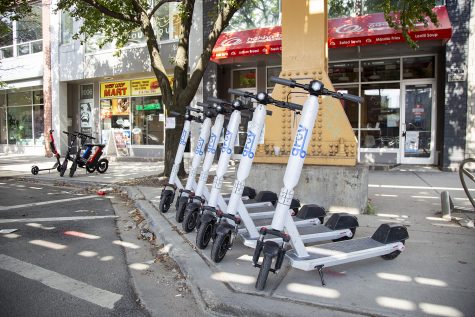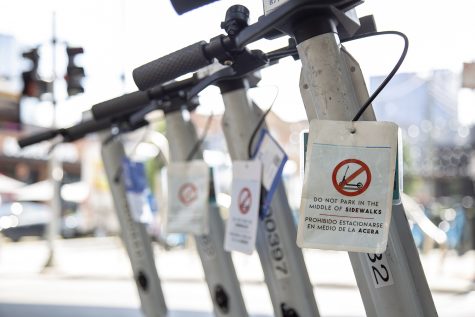E-scooters have e-normous issues, Chicagoans say
October 3, 2019

On Chicago’s West Side, shareable e-scooters, or electric scooters, can be found lined up in neat rows near CTA stations.
Throughout parts of Chicago’s West Side this summer, shareable electric scooters, or e-scooters, were seen zipping up and down city streets or in some cases tossed haphazardly onto sidewalks, driveways and lawns, dredging up multiple concerns from residents.
In less than two weeks, the pilot program, which allowed 2,500 e-scooters—with 10 companies each providing 250 onto a 50-square mile pilot area—will conclude and citizens will await a thumbs up or down on the addition to motorized traffic in the city.
Following other major U.S. cities such as San Francisco, the Chicago Department of Transportation and the Department of Business Affairs and Consumer Protection launched its E-Scooter Share Pilot Program to run from June 15 to Oct. 15.
Logan Palmer, a 22-year-old resident of Logan Square, said he scours the sidewalks for an e-scooter to rent every morning and night to ride to and from the Logan Square Blue Line station.
“You’re living in Chicago, so you are walking all the time. Anytime I see a scooter … it’s like a little victory,” Palmer said.
To use an e-scooter, users download the company app that corresponds to the scooter. After loading funds onto the app—generally $1 to access and 15 cents per minute to ride—an e-scooter can be unlocked.
The scooter pilot area is roughly bounded by Irving Park Road to the north, the North Branch Chicago River and Halsted Street to the east, the South Branch Chicago River to the south, and Harlem Avenue to the west, according to the city’s website.

E-Scooter guidelines show “DO NOT PARK IN MIDDLE OF SIDEWALK,” although many drivers continue to do so.
Ald. Byron Sigcho-Lopez (25th Ward), whose near-South Side Ward includes Pilsen, Chinatown and parts of the West Loop, said some residents are concerned about the disposal of scooters, but he added the program is just a test run, and if residents have concerns, they should call Chicago City Services at 311.
Huu Nguyen, a director on the board of the Logan Square Neighborhood Association, said motorized vehicles are not permitted on the Bloomingdale Trail, otherwise known as The 606—an elevated greenway and trail network that leads to the city’s Northwest Side—however, this has not stopped some e-scooter users from riding on it.
“It’s just dangerous … there is a lot of [pedestrian and bike] traffic up there, in varying speeds with so many mixed-uses,” Nguyen said. “I am surprised I’ve not seen anybody get clotheslined.”
The city has identified scooter traffic on The 606 as an issue and has since required the 10 companies to update their geofencing technology, making scooters slow down and eventually shut off when a user tries to ride on the trail, according to a Sept. 24 press release from BACP.
That same geofencing technology prevents scooters from leaving the boundaries of the pilot area, according to the CDOT website.
But some have questioned the effectiveness of the geofencing technology.
In a July 2 tweet, Ald. Brendan Reilly (42nd Ward) sarcastically wrote:
Nice job with that “Pilot” program @ChicagoDOT – this fella is “piloting” his “geofenced” scooter at Clark and Hubbard. One mile east of the “Pilot Area.” I predict a November vote to ban this crap. pic.twitter.com/jEoKVBqwZG
— Brendan Reilly (@AldReilly) July 3, 2019
Isaac Reichman, spokesperson for the BACP, said the city tested the geofencing technology of all ten companies. Of the ten, only Bird was cited for scooters failing to come to a complete stop when they left the pilot area, although the scooters did slow down.
Additionally, the BACP issued citations to Bird, Bolt, VeoRide and Wheels for failing to provide a timely response to complaints of not collecting scooters outside the pilot zone within two hours of being notified.
The BACP has issued 39 citations since the beginning of the pilot program in June, each costing up to $1,000. These citations include: not responding to consumer complaints within two hours, not having a light on the front of scooters and not having a functioning bell attached to scooters.
Nguyen said her only other priority ahead of accessibility is safety. Riders should be required to wear helmets, and if they cannot afford one, the city should provide one for them, Nguyen said.
With the pilot program nearing the cut-off date — Oct. 15 — the city is looking for feedback from Chicagoans. The BACP launched an online survey, inviting riders and non-riders to review their experience with scooters. Coinciding with the survey, the city will also assess ridership data, scooter-related injury reports from local hospitals and feedback from community groups.
Following the survey end date on Oct. 27, multiple city departments will compile a report, which will be the holistic evaluation of the program. Then, the city will decide how to move forward, however, there is no timetable for the next steps beyond the report, Reichman said.
The Active Transport Alliance, a non-profit advocacy organization that works to improve conditions for bicycling, walking and transit, is one of the groups compiling feedback from community members who live within the boundaries of the pilot program.
Kyle Whitehead, managing director of public affairs at the ATA, said there is clear enthusiasm for the e-scooters based on the number of rides and responses from residents who use them in the pilot area. However, he said some residents are still raising major concerns.







